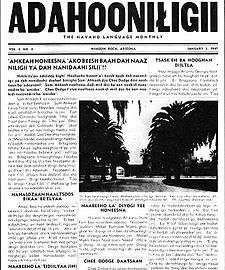Ádahooníłígíí
|
Frontpage of Ádahooníłígíí [1] | |
| Type | monthly newspaper |
|---|---|
| Owner(s) |
Navajo Agency, Bureau of Indian Affairs |
| Editor |
Robert W. Young William Morgan, Sr. |
| Founded | 1943 |
| Language |
Navajo (1943–1947) Navajo and English (1947–1957) |
| Ceased publication | 1957 |
| OCLC number | 17364489 |
Ádahooníłígíí (IPA: [átàhòːníɬíkíː] Navajo: "occurrences in the area/current events"[2]) was a Navajo-language monthly newspaper that was published in the Southwestern United States from 1943 to 1957.[3] After the Cherokee Phoenix, operating from 1828 to 1834, it was the second regularly circulating newspaper in the United States that was written in a Native American language. It was the first newspaper to be published in Navajo[4] and the only one to have been written entirely in Navajo.[5][6]
History
Ádahooníłígíí was published by the Navajo Agency of the Bureau of Indian Affairs in Window Rock, Arizona from 1943 to 1957. It contributed to the standardization of Navajo orthography as it was widely distributed.[7] Until that time, the only widely available texts intended for a Navajo audience had been religious publications and parts of Diyin God Bizaad (a Navajo translation of the Bible).[5] Its first issue was published in 1943. The paper was edited by Robert W. Young and William Morgan, Sr. (Navajo), who had collaborated on The Navajo Language, a major language dictionary published that same year.[8]
The newspaper was printed on a single folded sheet of newsprint; it was distributed through the chapter houses.[9] From 1943 to 1947, it was written entirely in Navajo. After that, articles were published bilingually or with an English summary of its contents. In its early years, the paper's main editorial function was to convey the opinions of "Wááshindoon" regarding World War II to the Navajo people.[4] In addition, it provided a connection between those Navajo who served in the United States military and those who had remained at home.[5]
As the effects of the federal government's Indian termination policy reached the Navajo Nation in the 1950s,[7] the paper's funding was withdrawn by the BIA. Ádahooníłígíí ceased publication in 1957. Shortly thereafter, the Navajo Times – written in English – began publication. It continues as the Navajo Nation's main print-medium to this day.
See also
References
- ↑ January 1, 1947. (Headlines: "[Sam] Ahkeah wins election, becomes Tribal Chairman" – "Hotel in Georgia burns down" – "Earth captured on photographs from space" – "[Henry] Chee Dodge dies")
- ↑ Young, Robert W. & William Morgan, Sr. The Navajo Language. University of New Mexico Press. Albuquerque, New Mexico: 1987.
- ↑ McCarty, T.L. & Fred Bia. A place to be Navajo: Rough Rock and the Struggle for Self-Determination in Indigenous Schooling. Erlbaum Publishers. Mahwah, NJ: 2002. p.51
- 1 2 Potowski, Kim. Language Diversity in the USA. Cambridge University Press. Cambridge: 2010. p.59
- 1 2 3 Cobarrubias, Juan & Joshua A. Fishman. Progress in language planning: international perspectives. Gruyter & Co. Berlin: 1983. p.238f
- ↑ Worldcat.org lists only one newspaper with Language:Navajo.
- 1 2 Hinton, Leanne & Kenneth Locke Hale, eds. The green book of language revitalization in practice. Academic Press. San Diego, California: 2001. p200.
- ↑ Sharon Hargus, "Review: Analytical Lexicon of Navajo by Robert W. Young; William Morgan; Sally Midgette", Anthropological Linguistics, Vol. 38, No. 2, Summer, 1996, JSTOR, accessed 2 October 2014 – via JSTOR (subscription required)
- ↑ Lockard, Louise & Jennie De Groat. "He Said It All in Navajo!" in: International Journal of Multicultural Education. 2010. Vol. 12, No. 2
